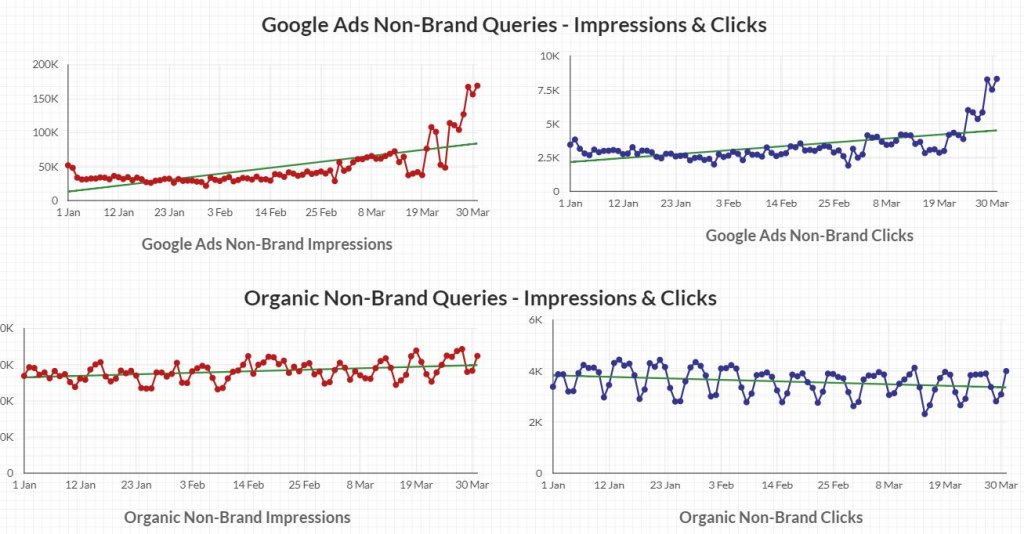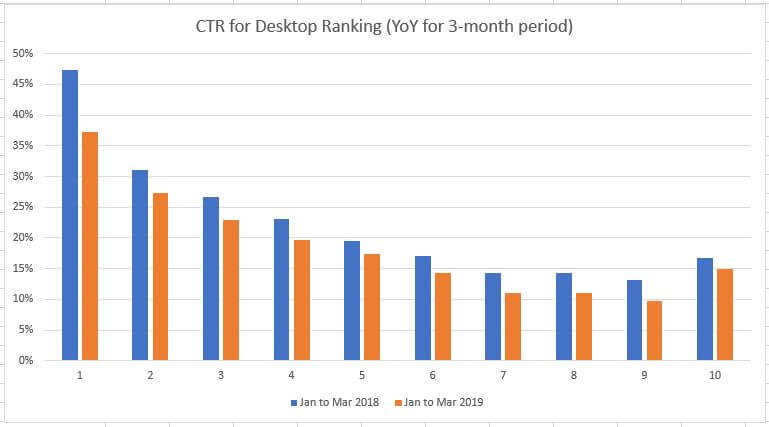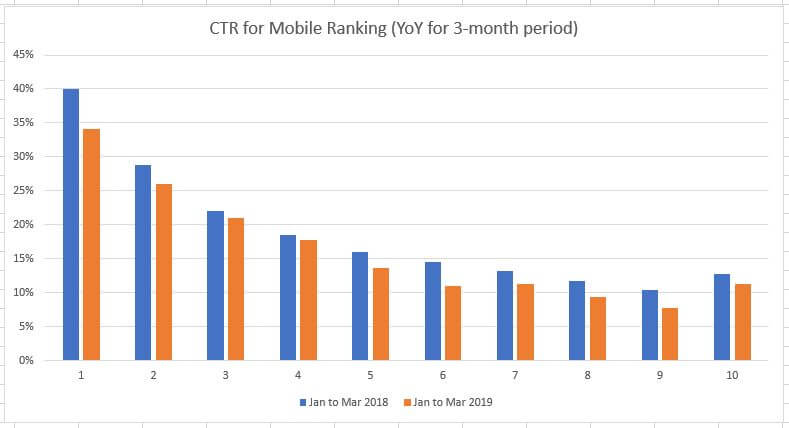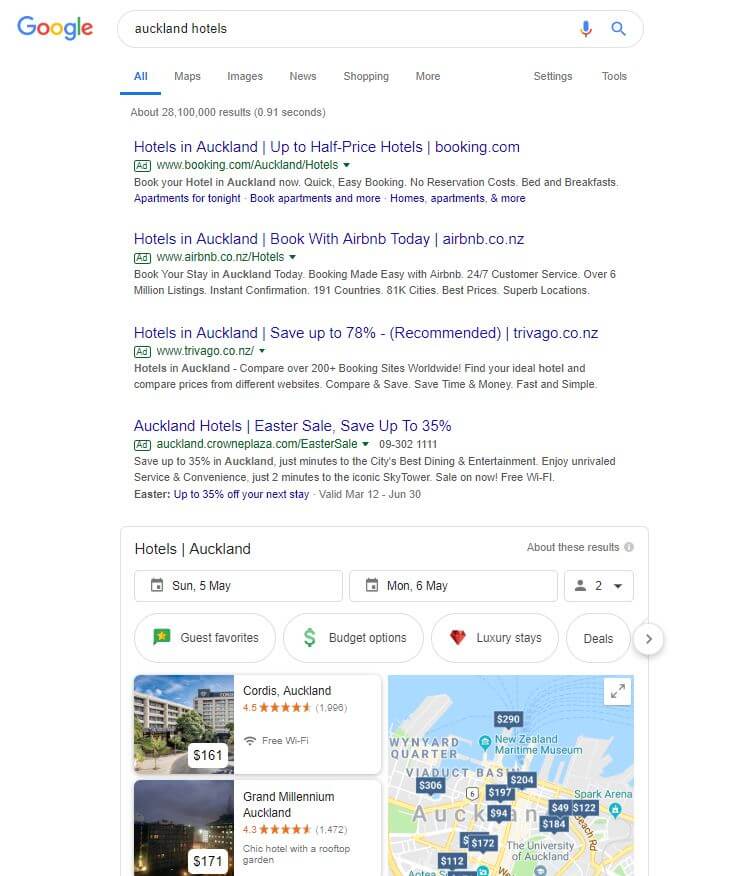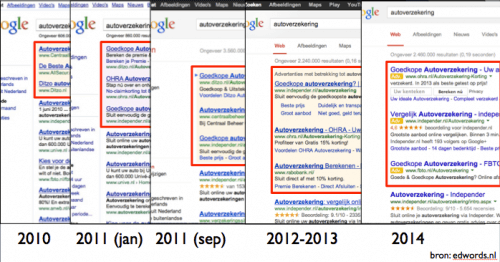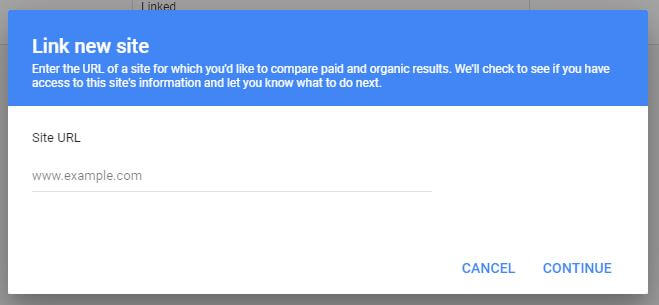If you’re running both an SEO program and paid marketing campaigns, how exactly does the relationship work? Is it a symbiotic relationship? Is ranking in both the organic listings and the paid listings mutually beneficial? Or is there a cannibalistic relationship, where you end up paying for clicks that you should be getting for free?
We recently took a closer look at one of the campaigns we are running where we’ve started seeing a considerable drop in organic traffic as we started to push budget to our paid campaigns to grow it aggressively.
Overall Traffic and Clicks:
Looking at the overall traffic and clicks for non-brand campaigns in Google Ads versus the non-brand traffic and clicks from Search Console, we see the following results:
The charts show the trend over the last 90 days for Non-Branded Queries from Google Ads and Organic. There has been a sharp increase in both impressions and clicks in Google Ads. For organic, on the other hand, impressions have an upward trend which is indicative of positive growth in visibility (we are ranking better for keywords). However, clicks are on a downward trend — this means that while we are ranking for search terms, people are not finding the client’s organic result relevant or are more enticed to click on other results.
While it did raise concerns, it wasn’t enough for us to conclude that there was a cannibalisation problem. So, we took it a step further.
CTR per Position
A more definitive way of identifying a potential cannibalisation issue is to look at the CTR of ranking keywords. To do this, we pulled the data from search console taking the average clickthrough rate of keywords occupying position 1, 2, 3 until position 10 in the first page of the search results for the last 3 months (Jan to Mar) comparing the CTR for these between 2018 and 2019.
We also removed all branded queries from as this heavily skews the data (don’t worry, we’ll get to brand in a bit!)
The data is interesting. A good example to look at would be the CTR for keywords in the first position for desktop search results. From January to March 2018, keywords holding position 1 had an average CTR of 47%, while for the same period in 2019, the CTR is down to 37%.
What is happening?
Even if we have better visibility — whether this is a result of ranking higher or increasing the number of keywords we rank for organically — actual organic traffic to the site will be less than last year because people are less inclined to click on the organic listing.
There are several possible reasons for this:
- More ads are being shown for the search queries
- Larger ad format gives more SERP real estate to ads
- Labeling of ads have changed over the two time periods, making it less obvious to the user
- SERP features are also taking valuable space in the results page
Below is an example worth looking at. For the keyword “Auckland hotels”, the search engine results page (SERP)*, shows 4 Google Ads – this already takes up the first virtual fold. You will need to scroll down to find the organic listings. However, on top of that, there’s Google Hotel Ads and a map. 4 organic results follow this. Then, the SERP feature for Top Stories is shown. Another 5 organic results. At the bottom of the page, you’ll see another set of ads.
(*Note that SERP results may vary per location and are affected when you are logged in to your profile)
In short, the #1 rank in organic is no longer the #1 position in the search results.
An interesting study by Edwords captures the evolution of the SERPs with this series of photos. In a span of 4 years, Google Ads have taken up more real estate than organic as shown below:
FIRST has also been monitoring the trend of SERP features since late 2017. Shopping ads, local packs, image results, video results, featured snippets, questions and more are also taking up valuable space in the search results.
Creating a Synergistic Strategy
The SERPs will continue to evolve and your competitors understand the value of paid campaigns. The Ads will continue to push down organic results taking clicks (and by extension, traffic) from organic.
Is there keyword/traffic cannibalisation or is it just a myth?
The cannibalisation has always been happening. It is by Google’s design. In this case, the increased performance of paid campaigns has an impact on organic, but may not be as big as we thought. The cannibalisation is more a result of the general SERP changes that Google is doing versus the paid campaigns encroaching on the keywords we target for organic.
Looking at it from the other side of the coin, you may ask if SEO is still necessary at this point? Why not drop the SEO and focus just on paid marketing?
The answer is quite simple, paid ads require a budget and you cannot possibly target all keywords (unless you have an infinite budget and are fully aware of what organic keywords your site is ranking for that bring in traffic).
It is understandable to direct most of your paid campaign budget towards transactional keywords that have a higher potential to convert. But the buyer’s journey is not always that straightforward. Buyers tend to do research and want to be educated about products before making a purchase. This is where your website’s organic rankings come in.
You can use well-optimised blog posts or category pages to target keywords that focus on the top of the funnel – those that pertain to educating the buyer about your industry, about the existence of your products and services.
If you want to further investigate the relationship between Organic and Paid, we recommend going at it with a more granular scope. Run a keyword diagnosis for both your paid campaigns and organics. Eliminate other likely causes of traffic decline.
A good tool to use would be the Paid & Organic Report within Google Ads. To access this report, you will need to link your Google Search Console property to Google Ads.
Login to your Google Ads account, click on Tools > Setup > Linked Accounts. Click on Search Console. This will open a prompt that lets you add the Search Console account.
You need to be a verified owner (not just a delegated owner) for the property in Search Console to be able to do this. Otherwise, you can send a request and the owner can approve it for you.
Once you’ve successfully linked the two, you can go Reports > Predefined Reports (Dimensions) > Basic > Paid & Organic. This will show you a table of Search Terms, Search Result Type (Ad Shown only, Organic shown only, Both Shown) and performance metrics.
This powerful report can help you decide on several things. First, it helps identify keywords that are missing in one channel or the other. Second, it can be a valuable tool for testing – if you have keywords that rank well for both organic and paid, you can use the data to experiment pausing campaigns or throttling back bids to see if organic search traffic and conversions have significant increases. On the flip side, if you find keywords that are not doing so well in organic rankings, you may want to test supporting these further with paid ads.
Your Brand Strategy
This article covers the impact of running both an SEO program of work and a paid campaign to non-brand keywords. So, what should you be doing about brand?
FIRST recommends that you bid on your brand terms.
We always get that initial reaction from clients: “Why do I need to bid on my own brand terms? I’m obviously already ranking #1 for it!”
There are three main reasons why you should invest in a brand campaign:
- Brand awareness – Google released a study in 2011 showing how search ads drive 89% incremental traffic. In our own research, we found that running ads alongside having a good SEO program has resulted in as much as 20% increase in organic traffic. Of course, this varies across different industries. The main driver of the increase in organic traffic is increase in brand awareness.
- Protection from Competitors – For some cutthroat industries, an easy win for your competitors would be to bid on your brand terms. You can file a trademark complaint with Google if you have your brand name trademarked and they can apply certain restrictions but there are things that your competitors can still get away with (such as using your trademark as keywords or in the display URL). Your best defense would be to bid on your own brand terms so you at least take one of the four available spots in the Ad results.
- It is relatively cheap to do it – Because you have a higher quality score on your own brand terms, your cost per click would be significantly less for your own brand terms versus what the competitors will be paying for it.
- Highlight promotions and offers – Another advantage of bidding for brand is the ability to highlight offers and to take people straight to the relevant pages, which will make them more likely to convert into a sale. If your product or service has a longer buying cycle, paid ads can be used to show other forms of contact such as phone numbers on mobile devices.
In conclusion, FIRST Digital highly recommends running both an SEO program of work and a paid campaign for brand and non-brand terms. If anything, having visibility in both the organic results and the paid results increases your chances of getting that visitor to click through to your website.

